An early ripe variety of Rosar potatoes for the northern regions
Summer residents and farmers grow potatoes to feed their families and get a good profit from sales. Today we'll talk about the Rosar variety. Vegetable growers choose it for its high yield and the ability to cultivate it even in Siberian climatic conditions.
The content of the article
Description
The height of semi-spreading potato bushes reaches 55 cm. The foliage is green, the inflorescences are red-purple. The flower is ovoid with a pubescent base. Up to 14 medium-sized tubers are formed under the bush.
Under good weather conditions and proper care, up to 20 potatoes are harvested from each.
Difference from other varieties
According to the characteristics, Rosara potatoes - one of the most common early table varieties.
Rosara differs from other varieties in compactness. The tubers of this potato are located in the ground in bunches, do not creep away, therefore, they are practically not injured during harvesting.
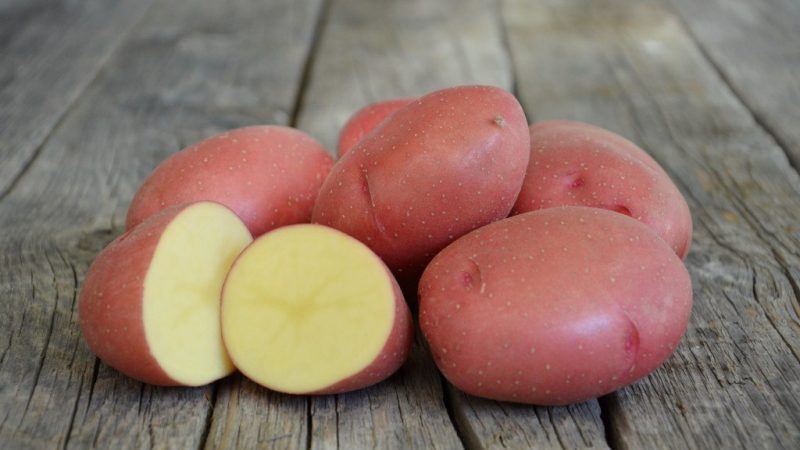
Chemical composition, trace elements and vitamins
Several vegetables contain a week's supply of all the nutrients your body needs. 100 g of potatoes contains 75 kcal, 0.1 g of fat, 1.9 g of protein, 16.5 g of carbohydrates and 14.2 g of starch. Potato composition:
- alimentary fiber;
- water;
- B vitamins - B1, B2, B3, B6, B9;
- vitamins C, PP, H;
- sodium;
- potassium;
- selenium;
- tin;
- chromium;
- phosphorus;
- magnesium;
- molybdenum;
- nickel;
- folic acid;
- calcium;
- silicon;
- iron;
- cobalt;
- aluminum;
- vanadium;
- iodine.
Tuber characteristics and yield
Rosara tubers are even and strong, the skin color is from pinkish to reddish-pink. The average weight of one vegetable is 115 g. The flesh of a potato is light yellow; it darkens slightly when peeled, sliced and boiled. The eyes of vegetables are small, unexpressed.
In the initial stages of the growing season, the culture develops rapidly. Ripening of tubers begins 45-50 days after the first shoots. Vegetables reach full technical ripeness in 65-70 days.
If all agrotechnical rules are observed, vegetable growers collect up to 500 kg of potatoes from 1 weave. Yield indicators are maintained for 5 years without changing the planting material.
The crop gives the highest yield in the middle latitudes. However, vegetable growers who grow potatoes in the north of Russia note that with temperature drops, quality and yield indicators also remain high.
For your information. Due to its low sugar content, the product is recommended for people with diabetes.
Growing regions and planting dates
Description of the Rosara variety, photos of potatoes and reviews allow us to call it one of the best on the domestic market. The plant tolerates hot and cold weather, and even humid climatic conditions well.
The culture is grown in the vast majority of regions of Russia:
- Central Black Earth Region;
- North Caucasus;
- Northwest;
- Urals;
- Siberia;
- The Far East.
The exact timing of planting potatoes is extremely difficult to determine, given the characteristics of different regions and climatic conditions. Seeds are planted in well-heated soil - from + 10 ° C. This is usually late March or early April. In regions with a cold climate, planting work is carried out in the last days of April.If you plant tubers when there is still a threat of return frosts, the potatoes will develop slowly or die.
Advantages and disadvantages of the variety
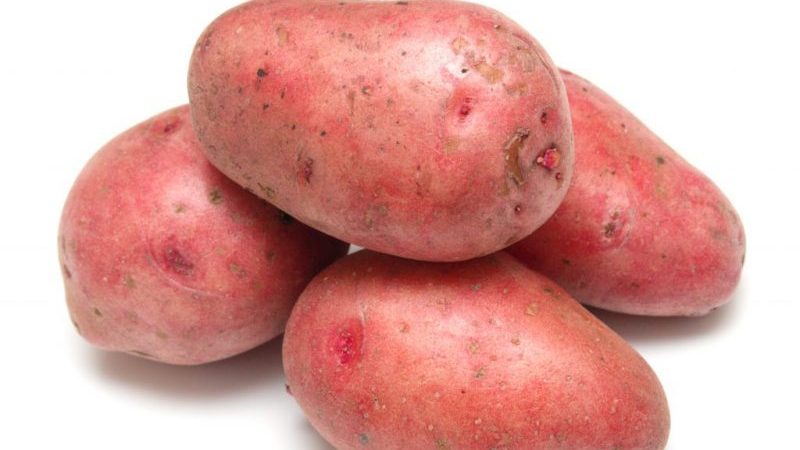
Each variety has positive and negative sides. Rosara has more advantages. These include:
- Strong immunity to disease. Good resistance to gold nematode, potato crayfish and scab tubers.
- Fast adaptation to climatic conditions. The variety tolerates drought, cold weather and heavy rainfall well.
- Early maturity. Potatoes ripen in just 2 months. This is especially important for regions with short summers.
- High productivity. Vegetables are stored from a small plot for the whole winter.
- Planting seeds do not need to be renewed frequently. They are used for up to 5 years, while the characteristics of the tubers do not change.
- The versatility of potatoes in cooking. Its taste makes it possible to prepare many different dishes from it. Even after prolonged heat treatment, the tubers do not boil over and retain the pleasant taste of butter.
- The attractive appearance of the potato allows you to cultivate this variety not only in summer cottages for personal use, but also in large farms for wholesale.
But Rosara also has disadvantages, namely:
- Plants fall early to the ground, scatter. This makes the process of weeding and hilling difficult.
- Foliage is often affected by late blight, which is why chemicals have to be used.
- The fried potatoes are too hard.
Against the background of the positive qualities of Rosar's potatoes, the shortcomings are almost invisible, so many vegetable growers prefer this particular variety.
Features of planting and growing
The correct cultivation of potatoes brings a high-quality and rich harvest. The tubers that the grower receives in the first year will differ in color, size and shape. The main task of the farmer is to select the best of them.
Preparing for landing
Potatoes are grown on sandy loam or loamy soil, which has been prepared since autumn. Weeds are removed and the soil is dug to a depth of 30 cm. The plot is taken out well lit. In a shaded area, the culture will develop slowly.
Planting material is also prepared. The tubers are germinated to shorten the growing season by 7-12 days. After the appearance of growth buds, the seeds are covered with wet sawdust with a layer of 3-4 cm. As they dry, they are sprayed with any solution of a biostimulator, for example, "Mikon", "Epin", "Heteroauxin".
About 2 weeks before planting, the tubers are left in the sun so that they acquire a greenish peel. This increases the yield and resistance of potatoes to a possible attack by pests.
Landing scheme and technology
Potatoes are a thermophilic plant and should not be planted in early spring. If the Rosara variety is planted at the end of May, the crop can be harvested already in early August. Potatoes are planted according to a certain pattern:
- For loamy soil, the holes are made 10 cm deep, for sandy loam - 15 cm.
- A distance of 40 cm is left between the pits.
- A small amount of humus and 20 g of wood ash are added to the holes.
- Potatoes are placed in the wells, sprouts up.
Growing features
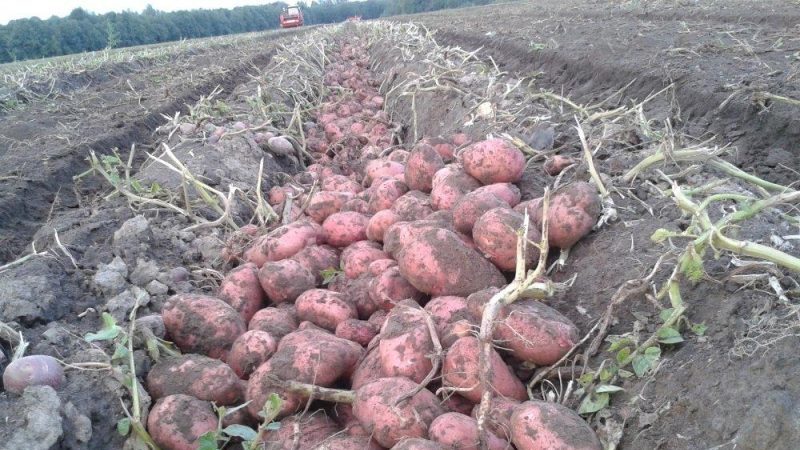
The variety does not lose its positive characteristics for 5 years, but, despite this, it is still necessary to periodically change the planting material. The soil is depleted over time, pathogens accumulate in it, which negatively affects further yields, and this does not depend on the climatic zone.
If it is not possible to purchase expensive tubers, they are grown independently from purchased seeds. They will be suitable for landing only next year.
Important! Deep planted tubers produce small vegetables and an abundance of tops.
7 days after planting the seed, the first loosening is carried out. This contributes to the rapid and friendly appearance of sprouts on the soil surface.The second time, the procedure is combined with the removal of weeds. Plants by this time grow to 7-10 cm. When the bushes reach 15-18 cm, the first hilling is done. After 2 weeks, the event is repeated. The more land above the tubers, the better for yields.
Watering mode
In dry weather, the culture is watered 2-3 times during the entire growing season. Moistening is carried out during the flowering of plants and after the withering of the flowers. At this time, potatoes are actively gaining mass. In order not to disturb hilling, drip irrigation is used. About 5 liters of water are consumed per plant.
Top dressing
Potatoes do not need frequent dressing... For the entire season, plants are fertilized 2-3 times. To do this, use:
- potash and phosphorus fertilizers;
- wood ash;
- compost.
When shoots appear, chicken droppings diluted in water 1:10 and mineral fertilizers, for example, "Nitrofoska" or "Nitroammofoska", serve as a good fertilizer. Potash, phosphorus fertilizers and wood ash are used before flowering. Also, these components are introduced during the period of active flowering and leaf growth.
Disease and pest control
The Rosara potato variety has gained great popularity not only for its ease of growing, but also for its strong immunity to diseases and pests, which greatly facilitates the care of plants.
Causes great harm to culture Colorado beetle. He eats tops and tubers. The beetle is fought with traps. Lure him with chopped potatoes. The pest is exterminated by spraying the bushes with a urea solution (100 g per 10 liters of water). Processing is carried out in the morning or evening. Some vegetable growers use the drug "Confidor".
Of the diseases, the culture is most often affected by late blight. The diseased plant is covered with small brown spots, which rapidly increase and move to the stem. In dry weather, the infected bush dries up, in rainy weather it begins to rot. Vegetables on which phytophthora has settled spoil right in the ground. A layer of dry rotting tissue forms under the skin. They fight late blight by spraying potatoes with the preparation "HOM" (40 g per 10 liters of water).
Important! If the plants begin to turn black from late blight, the affected areas are removed and burned.
Growing difficulties
The area for growing potatoes is changed after 2-3 years of use. When choosing a new location, attention is paid to predecessor cultures.It is better if they are:
- cucumbers;
- cabbage;
- winter crops;
- lupine;
- linen;
- legumes;
- one - and perennial herbs.
Areas where nightshade crops grew are unsuitable for potatoes. Crop rotation is observed so that diseases to which the variety is unstable are not transmitted through the soil.
Harvesting and storage
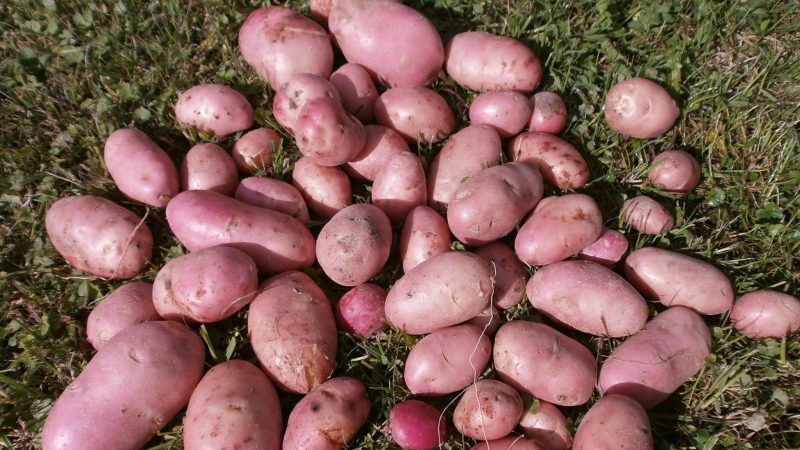
It's time to harvest when the tops are dry and sink to the ground. It is cut off, and after a week the potatoes are dug out. To keep the crop longer, it is laid out in one layer in the sun for 2-3 hours, then sorted and placed in boxes.
The tubers, which have the most eyes, are laid aside for landing for the next season. Damaged vegetables are immediately used for consumption. Potatoes affected by diseases or pests are disposed of. Store the crop in a basement or cellar. The storage area is periodically ventilated.
Tips from experienced gardeners
Experienced growers have learned to increase yields using some tricks:
- Potatoes are grown in a ridge method using rotted sawdust and straw. This method significantly improves the quality and quantity of tubers.
- Potatoes are planted on the ridges in early spring. So plants use reserves of winter-spring soil moisture, which increases the number of tubers.
To ensure a high yield, make the right bedding, using rotted sawdust, cut dry grass or rotted straw. Organic litter helps the soil warm up in a short time, and when it decomposes, the culture receives additional nutrition.
Reviews of the Rosara variety
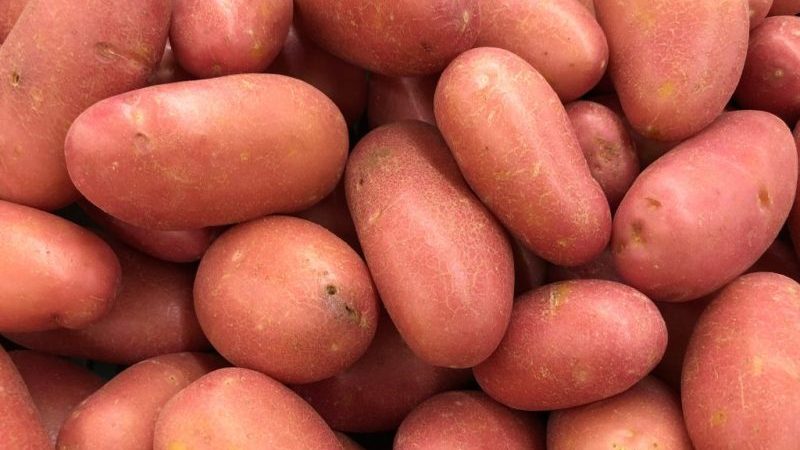
Those who grew Rosar's potatoes. speak positively about this variety.
Nina, Orsk: «Several years ago, a neighbor suggested Rosar's potatoes to me. The variety has proven to be resistant to our climate. Plants practically do not get sick. The taste of vegetables is excellent. The potatoes are large, not boiled. The seed has not been renewed for 4 years, and the potatoes retained their characteristics. I really like this variety, I recommend it to everyone. "
Stanislav Tula: “We have been growing potatoes with my wife for 10 years for ourselves and for sale. For the last 3 years we have been planting Rosana and Rosar potatoes. We like the second grade better. Vegetables keep well. The taste of the variety can be rated as the best. In care, the culture is unpretentious, the bushes are tall and beautiful. I have never had any problems with growing this variety. I also want to point out that Rosara has a strong immunity to disease. We will continue to grow this variety! "
Conclusion
Try growing Rosara potatoes. Unpretentious care is a significant plus of culture. Plants have good resistance to temperature extremes, so they give a bountiful harvest even in the coldest regions. This promising variety is grown for personal use and sale.